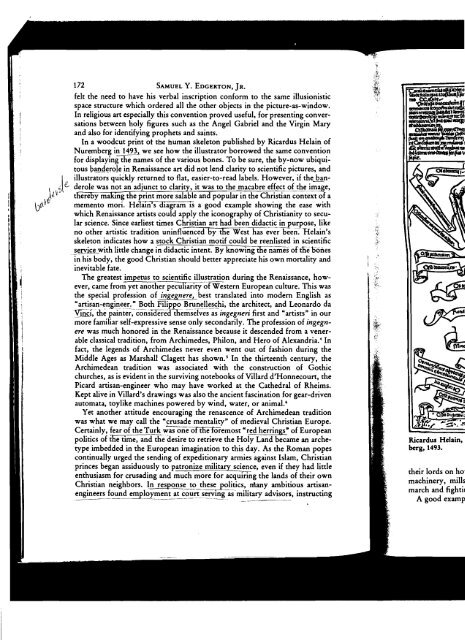The Renaissance Development of the Scientific Illustration - Winthrop
The Renaissance Development of the Scientific Illustration - Winthrop
The Renaissance Development of the Scientific Illustration - Winthrop
Create successful ePaper yourself
Turn your PDF publications into a flip-book with our unique Google optimized e-Paper software.
felt <strong>the</strong> need to have his verbal inscription conform to <strong>the</strong> same illusionisticspace structure which ordered all <strong>the</strong> o<strong>the</strong>r objects in <strong>the</strong> picture-as-window.In religious art especially this convention proved useful, for presenting conversationsbetween holy figures such as <strong>the</strong> Angel Gabriel and <strong>the</strong> Virgin Maryand also for identifying prophets and saints.In a woodcut print ot <strong>the</strong> human skeleton published by Ricardus Helain <strong>of</strong>Nuremberg in 1493, we see how <strong>the</strong> illustrator borrowed <strong>the</strong> same conventionfor displaying <strong>the</strong> names <strong>of</strong> <strong>the</strong> various bones. To be sure, <strong>the</strong> by-now ubiquitousbaderole in <strong>Renaissance</strong> art did not lend clarity to scientific pictures, andskeleton indicates how a stock Christian motif could be reenlisted in scientificservice with little change in didactic intent. By knowing th-enameS <strong>of</strong>~tlie bonesin his body, <strong>the</strong> good Christian should better appreciate his own mortality andinevitable fate.able classical tradition, from Archimedes, Philon, and Hero <strong>of</strong> Alexandria.' Infact, <strong>the</strong> legends <strong>of</strong> Archimedes never even went out <strong>of</strong> fashion during <strong>the</strong>Middle Ages as Marshall Clagett has shown.' In <strong>the</strong> thirteenth century, <strong>the</strong>Archimedean tradition was associated with <strong>the</strong> construction <strong>of</strong> Gothicchurches, as is evident in <strong>the</strong> surviving notebooks <strong>of</strong> Villard dJHonnecourt, <strong>the</strong>Picard artisan-engineer who may have worked at <strong>the</strong> Ca<strong>the</strong>dral <strong>of</strong> Rheims.Kept alive in Villard's drawings was also <strong>the</strong> ancient fascination for gear-drivenautomata, toylike machines powered by wind, water, or animal.*Yet ano<strong>the</strong>r attitude encouraging <strong>the</strong> renascence <strong>of</strong> Archimedean traditionwas what we may call <strong>the</strong> 'crusade mentalityn <strong>of</strong> medieval Christian Europe.Certainly, fear <strong>of</strong> <strong>the</strong> Turk was ~.. one ot <strong>the</strong> toremost 'red herrings" <strong>of</strong> Europeanpolitics <strong>of</strong> txme, and <strong>the</strong> desire to retrieve <strong>the</strong> Holy Land became an archetypeimbedded in <strong>the</strong> European imagination to this day. As <strong>the</strong> Roman popesRicardus Helain,<strong>the</strong>ir lords on ha












